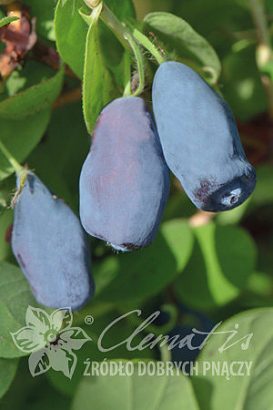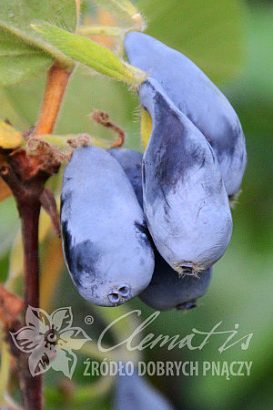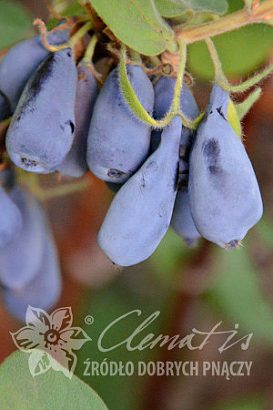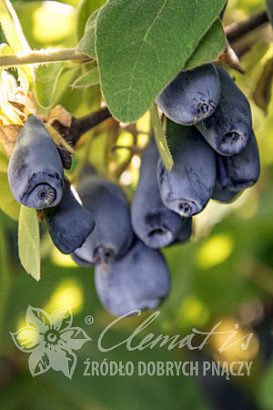Lonicera kamtschatica ‘Jolanta’
haskap (blue honeysuckle, honeyberry) 'Jolanta'| Decoration form | cultivated for its berries |
|---|---|
| Color of flowers | yellow |
| Flowering month | III, IV |
| Annual growth | 0.4-0.5 m |
| Aspect | sun, 3/4 sun, 1/2 sun |
| Frost hardiness | Zones 3 - 7 |
| Density on 1m2 | 1 |
| Evergreen plant | no |
A strong-growing cultivar of large, tasty, sour-sweet fruit ripening in May and June. Long-lived and frost hardy.
WHAT IT LOOKS LIKE: Fruit oblong, fusiform, dark-blue with a waxy film, very tasty sour-sweet; ripen May-June. Plants yield fruit in the 2nd–3rd year after planting. Flowers modest, pale yellow, rich in nectar, of no decorative value, open in March. Require cross pollination. The plant’s upright shoots are green when new and turn brown as they mature.
HOW IT GROWS: A shrub of an upright, round habit. Moderate growth rate of 0.5 m per year; maximum height 2.5 m.
WHERE TO PLANT: Yields fruit best when planted in light and penetrable soil, of slightly acidic pH. Does not require acidifying of the soil as opposed to e.g. highbush blueberry. Unlikely subject for pest and disease. Fully frost hardy (zone 3–7). Sensitive to draughts due to its shallow root system.
HOW TO PLANT AND MAINTAIN: Before planting immerse the plant container in water for 10-30 min. Place the root ball in a 40 x 40 x 40 cm hole with a 10 cm layer of well-rotten manure or compost, 0.5-1 cm deeper than it was before. Fill the hole with fertile soil. The plant does not require regular pruning. After a couple of years when the shrub becomes dense, thinning is recommended. Excessive pruning will limit fruition.
HOW TO APPLY: The shrub is recommended for amateur cultivation in domestic gardens. Yields fruit best when planted in a vicinity of other varieties of the species, e.g ‘Wojtek’ cultivar. Its berries are a valuable component of diet – rich in vitamins, macro and microelements (magnesium, iron, copper and iodine) they contain anthocyanins and ascorbic acid. They have antioxidant, anti-inflammatory and antiseptic properties. Delicious when eaten raw, excellent as an addition to jams, juice or tinctures. May be used as a natural red food dye.
ORIGIN: Raised by Zofia i Hieronim Łukaszewscy, Poland.










